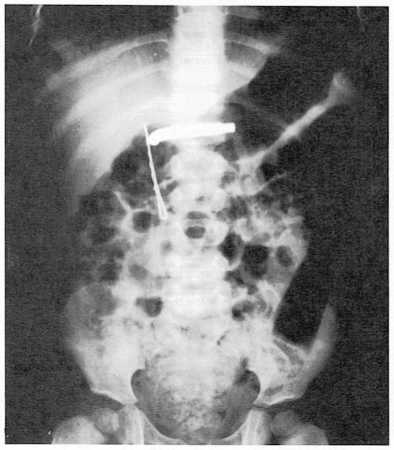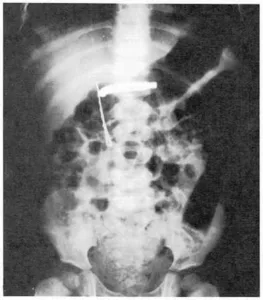Strep Throat – Swallowed Objects
Strep throat is an inflammation caused by a bacterium called the
streptococcus. A child with strep throat usually has a fever, lacks
energy, and has a sore throat—especially when swallowing. The lymph
glands in the neck are also swollen; and yellow, gi\’ay, or white
patches may appear on the tonsils.
If untreated, strep throat may lead to rheumatic fever, nephritis, and
other illnesses. For this reason, call your doctor if your child has a
sore throat and a fever, if the throat is more than mildly sore, or if
the sore throat persists.
Symptoms of strep throat are often the same as those for a sore throat
that is caused by a virus. To determine whether your child’s sore throat
is strep throat or virus-caused, your doctor may do a throat culture.
Usually, the doctor will treat strep throat with antibiotics.

**A child who has contracted strep throat may develop yellow, gray, or
white patches of membranous material on the tonsils.
M.G.
See also Communicable diseases; Nephritis;
Rheumatic fever; Sore throat; Swollen glands;
Virus
Stuttering is an interruption in the flow of speech caused by
repetition of certain sounds, prolongation of others, or hesitancy in
talking. A child who stutters in normal speech may not stutter when
singing, repeating memorized material, or acting in a play. Stuttering
occurs in about 1 child in 125. It is much more common in boys than in
girls, but no one knows why.
Primary stuttering. Between 2 and 5 years, most children pass
through a normal period called “primary stuttering,” or “transient
stammering.” The problem ordinarily disappears after six months or a
year.
Parents who are not aware that primary stuttering is normal may make a
child feel that there is a serious speech problem. They may show their
concern by facial expressions, by completing what the child is trying to
say, or by constantly telling the child to “take your time” or “start
over.” The best thing to do is nothing at all. Do not ask the child to
repeat what was said. Do not ask the child to slow down. Do not scold.
Accept this temporary period of stuttering as a normal part of
development.
If stuttering persists longer than usual or becomes severe, you may want
to discuss the problem with the child’s doctor.
Secondary stuttering. Secondary, or true, stuttering begins when the
child is aware of the difficulty and attempts to prevent it. As the
child tries harder to get the words out without hesitating, the muscles
involved in speech may move even less smoothly, and the child develops a
stuttering block. A stuttering child may attempt to break this block by
stamping the foot, jerking the head, or other maneuvers. The child may
use similar actions in anticipating difficulty with certain words or may
eventually avoid these words. The child may be reluctant to answer
questions at school or to speak on the telephone.
Children with secondary stuttering should go to a speech clinic. Your
doctor can tell you the location of the nearest clinic, [m
g]
cur when open-flame heating units—such as coal stoves, oil stoves, or
gas stoves—are operated in close, unventilated spaces such as trailers
or small cottages. These conditions produce excess carbon monoxide,
which prevents the hemoglobin in the blood from carrying oxygen
throughout the body. All open-flame heaters should be properly vented to
the open air. If a child is suffocating because of lack of oxygen in the
air, carry the child into fresh air before giving artificial
respiration.
Many infant deaths once attributed to smothering have been found to be
due to sudden infant death, [m.g.]
See also Accidents; Artificial respiration; Choking; Crib death;
Poisonings and poisons
Sugar diabetes. See Diabetes mellitus
Sty. See Eyelids
Suffocation is a state of unconsciousness that occurs when the body
does not get enough oxygen. Suffocation can cause death very quickly.
If your child is suffocating, the first thing to do is to give the child
air. The best method of getting air back into the lungs of children is
to administer CPR. (See CPR.) One person should begin this while
someone else calls the paramedics or, if not available, a physician.
Continue CPR until the child resumes normal breathing or until
professional help arrives.
A person whose air supply is cut off will suffocate. For example, a
child who stays underwater too long will drown. Also, a child may be
accidentally shut inside an airtight container such as a refrigerator or
buried under a pile of dirt. A child who puts a plastic bag over the
head may also suffocate. Some children have been strangled by poorly
designed harnesses intended to keep them in chairs. A baby may be
smothered under a thin sheet of plastic. On rare occasions a baby has
been accidentally smothered by an adult sleeping in the same bed.
Suffocation may also occur when there is not enough oxygen in the air.
This may oc-
Sunburn is the skin’s reaction to ultraviolet rays of the sun or to
artificially created rays from a sun lamp. Mild sunburn reddens the
skin. More severe sunburn may blister the skin or cause a fever.
For mild sunburn, apply cold cream. For severe sunburn, give fluids and
analgesics for pain and to reduce fever. Apply cold tap water compresses
to relieve pain. If the condition does not improve within a few hours,
call a doctor.
The safest way to avoid severe sunburn is to allow the skin’s protective
responses to develop by exposing the skin for a short time once daily at
first (perhaps 15 minutes), and then regularly increasing the length of
time. Suntan creams or lotions used before exposure are recommended for
protection.
Children with fair skin, and especially those with red hair, are prone
to sunburn. A number 15 sunscreen should be applied several times daily.
However, any skin—even if tanned—will burn if exposed too long. Do
not let your child stay too long in the sunshine, especially on the
beach. Reflected rays from the water intensify the effect of the sun.
Burning can also occur on hazy days. Recent studies have shown a greater
chance of developing skin cancer in people overexposed or repeatedly
(chronically) exposed to ultraviolet rays, [am m]
Suppositories are medical preparations that are usually inserted
into the rectum. Most are cylinders about 1 inch (2.5 centimeters) long
and 1/4 inch (6 millimeters) wide.
There are two kinds of suppositories. The more common one is made of
soap or glycerin and used to induce a bowel movement. Suppositories
should be used only when a doctor prescribes them. Their routine use
interferes with normal bowel function.
The other type of suppositories contains medicine for use in the rare
instance when certain types of medication are needed and cannot be taken
by mouth, such as medicines for constant vomiting.
Insert a suppository gently above the muscle ring at the rectum opening.
Hold the child’s buttocks together for a few moments, so that the
suppository will not be pushed out. If the suppository is pushed out,
wait a few minutes before trying again, [m.g.]
Swallowed objects. Children have a natural tendency to put things
into their mouths. Obviously, this tendency can be dangerous because a
child may swallow something

If a child swallows an iron or steel object, the doctor may have the
child swallow a small magnet attached to a string. Using X rays, the
doctor maneuvers the magnet until it attracts the object, and then
pulls the object out.
harmful. If your child swallows an inedible object, keep calm so that
you do not alarm the child. Since almost any inedible object may prove
harmful if swallowed, call the doctor. If the object is a sharp one,
such as a tack or an open safety pin, the doctor may want to X-ray the
child to determine whether surgery is needed to remove it.
Small, smooth objects such as fruit pits, coins, beads, and buttons will
usually pass through a child’s body without harm in a few days. Do not
give a laxative to the child. It will not help, and it may be harmful.
Instead, keep the child on a normal diet. If the child has abdominal
pain or vomits, call a doctor immediately. If you cannot reach a doctor,
take the child to a hospital.
Protect your child by keeping small objects out of reach. A string of
beads, for example, may be dangerous if the string breaks and the beads
come loose. Keep your button box well out of reach.
When you are changing diapers, close each safety pin as you remove it. A
closed safety pin will probably pass harmlessly if swallowed. An open
safety pin may not.
Do not give a young child toys with detachable small parts, especially
glass eyes, buttons, or bells. Do not give the child a toy that might
break into fragments that can be swallowed or breathed into the windpipe
and lungs. The small cadmium batteries used in calculators, cameras, and
watches are extremely dangerous if swallowed. Keep these stored out of
reach and discard them as soon as they are no longer being used.
As soon as your child is old enough to understand, encourage the child
to give you dangerous objects that he or she finds. You can then thank
the child and substitute a safe plaything. Remember, too, that children
are great imitators of their parents. Children who observe parents
holding open safety pins in the mouth, or nails or pins between the
lips, will probably duplicate the deed at the first opportunity,
[m.g.]

